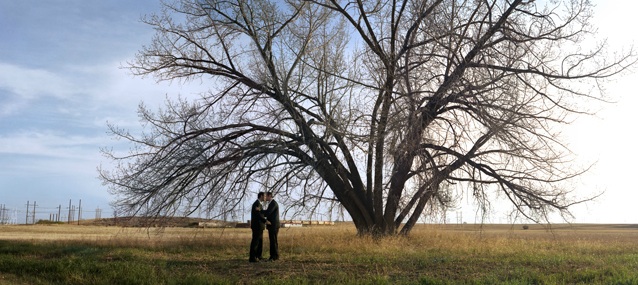Joyce Yahouda Gallery presents Consolation, a solo exhibition of four photographic self-portraits and a six-part narrative video by the Serbian-Canadian artist Milutin Gubash. The continual re-presentation of himself and his family and friends in a quasi-autobiographical investigation consitute the content of his artistic practice that encompasses photography, video and performance. Here we have a concise yet extremely rich sampling of Gubash’s output over the past three decades. Rich in detail, references and humour, these works continually compel curiosity and suspend conclusions. His work explores the grey areas between personal, family and political history, past and present, fiction and reality. By participating in the search for Milutin Gubash we are taken on a trip across many kinds of borders.
For example, the large-scale photograph entitled “Drinking from a river in Quebec pretending it’s the Tamis where it flows into the Danube near Belgrade” (2010) depicts a nude Gubash crouching at the riverside near Quebec City. The long shot makes him small and easy to miss, and the sudden recognition of his pale form lapping at the briny water is both funny and fantastical. In this actual location (Quebec City) that is simultaneously displaced by the title’s description, he has created a tension between the real and fictitious: he is both himself and some kind of man-beast in a moment of Arcadian repose.
To the right, in the vast photograph from which the exhibition takes its title, a twin vision of Gubash stands beneath a vast and solitary tree in a prairie landscape. The two figures wear identical funereal-looking suits and face each other; one appears to whisper something in the others’ ear. For what grief does he seek solace? Why this closed relation of Gubash and Gubash? The ground they stand on appears recently disturbed, as though someone has been buried there. Later, we learn in the video that he dresses like his dead father: is this a clue or merely incidental?
In “The Donkey” (2010) Gubash takes a turn towards the absurd, as he appears “caught,” like some businessman in a private fetish game, behind a nondescript shed in an improvised donkey costume. Pelts of fake fur are tethered to his suit with duct tape, the ears and nose likely created with something like toilet paper rolls. Is it irreverence or a tragicomic performance?
If you are moving through the gallery in the habitual clockwise direction, the last photograph is the earliest. A smaller, square photograph depicts a young Gubash in the 1980s posing next to a man he thought was interested in him. It demonstrates that Gubash’s agile steps around identity–here that of sexual orientation–have been a consistent facet of his practice from the beginning.
The self-portraits’ varying dimensions, technical style, differing periods of production and self-presentation attest to Gubash’s refusal to consolidate a linear trajectory of both time and personal development. Instead what we are confronted with are various episodes of Gubash’s performance of identity and investigations of his own and his family’s history, in the various geographical locations in which he has, or has had, or has maybe had, personal experience.
The video component, produced between 2008 and 2012, continues this performance in narrative form. In these six episodes of roughly 20 minutes each, Gubash has adopted several conventions and codes from television. At times it is the slapstick, laugh-track driven sitcom: in one part Gubash plays the hapless father, badly losing a backyard waterfight in a send-up of both suburban ease and conformity as well as the televisual entertainment that exploits it. At other moments it is the melodrama of the soap opera, and at others it is the confessional and uneventful intimacy of reality television. In all of them, the lines between past and present, between lived history and memory by proxy or testimony, and between fiction and reality, blur.
Gubash’s humour is an important strategy, for it tempers the potential seriousness that such a quest can imply, as well as the undercurrent of morbidity and failure that runs through his work. For example, in a car trip to the family’s former apartment building in Kingston with his mother and girlfriend–a building that he mirsrecognizes at first– he attempts to scatter his father’s ashes in a corner of the buliding’s exterior, with disastrous and messy results. His humour is also an effective tool for deflecting tendencies to over-determine his identity. For example, such comments as “Want to see where I grew up? Kingston, Calgary, Serbia” is a comical way to forestall over-identification with the artist’s Serbian heritage (having lived in Canada since seven years of age). His experience of Serbia, as demonstrated in the amusing episode where he visits his aunt in Belgrade, for instance, is both one of connection and alienation, memory-by-testimony and present misrecognition.
Beyond implicating a revolving roster of family and friends in his tireless “search” for roots, a search that ranges from Montreal to Hamilton to Belgrade, Gubash’s work seems to demonstrate a cultural politics of difference that goes beyond the personal. Perhaps it could be understood as a microcosm of the increasingly globalized and decentred world that is far more complex than the simple division between “east” and “west.” In his essay “A Place Called Home: Identity and the Cultural Politics of Difference,” Jonathan Rutherford has suggested that we use the word difference as a motif for that uprooting of certainty of one’s identity–indeed a strategy at the core of Gubash’s practice. Rather than trying to consolidate (his) identity, Gubash’s work slyly points to the unfixed and ‘overdetermined’ character of identities, recognizing both their interdependent and relational nature.
This thought-provoking and engaging exhibition runs until October 6, and on September 28 will be joined by the Milutin Gubash survey exhibition Les Faux Semblants at Musée d’art de Joliette, which continues until December 30, 2012.
Galerie Joyce Yahouda, space 516
Milutin Gubash
Consolation
August 23 – October 6, 2012
www.joyceyahoudagallery.com




1 Comment
Comments are closed.